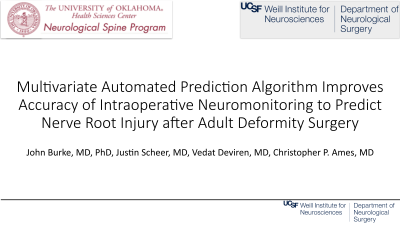Multivariate Automated Prediction Algorithm Improves Accuracy of Intraoperative Neuromonitoring to Predict Nerve Root Injury after Adult Deformity Surgery
Multivariate Automated Prediction Algorithm Improves Accuracy of Intraoperative Neuromonitoring to Predict Nerve Root Injury After Adult Deformity Surgery
Friday, April 21, 2023


John F. Burke, MD, PhD
Physician
Oklahoma University
Oklahoma City, Oklahoma, United States
ePoster Presenter(s)
Introduction: Intraoperative neuromonitoring (IONM) utilizing transcranial motor evoked potentials (TCMEP) can reliably detect spinal cord injury, but has limited ability to detect neurological deficit in nerve roots after adult spinal deformity (ASD) surgery. We hypothesize that, multivariate decision algorithms should improve the ability of IONM to detect postoperative neurological changes.
Methods: A pilot set of thirty-four ASD cases with complete neuromonitoring data were identified from a single surgeon cohort. Normalized changes in the motor evoked potential TCMEP were used to create a decision variable (DV), and a multivariate logistic regression (LR) classifier used the DV in combination with patient frailty, age, and surgical complexity to predict post-operative deficits. The sensitivity, specificity, positive predictive value (PPV), and negative predictive value (NPV) of human alerts and the multivariate LR were compared. The correlation was found using Pearson’s linear correlation coefficient and the quality of the prediction was tested by calculating the area under the curve (AUC) using a receiver operating characteristic (ROC) analysis.
Results: Of the 34 cases in this pilot series, 11 patients (32.3%) had a new post-operative neurological deficit at least 6 weeks follow-up. For patients who developed motor weakness post-operatively, the average drop in motor score was 4.8 points (MRC grading system). The sensitivity and specificity of intra-operative neuromonitoring staff alerts were 0.36 and 0.65, respectively (PPV: 0.33, NPV:0.68). The sensitivity and specificity of the multivariate classifier were 0.55 and 0.91, respectively (PPV: 0.75, NPV:0.81) with an AUC of 0.77. The magnitude of the classification signal was significantly correlated with the degree of post-operative weakness (r=0.44, p=0.009).
Conclusion : These data highlight how predictive analytics, in combination with IONM, can significantly improve the ability to predict post operative deficits after spinal surgery.
Methods: A pilot set of thirty-four ASD cases with complete neuromonitoring data were identified from a single surgeon cohort. Normalized changes in the motor evoked potential TCMEP were used to create a decision variable (DV), and a multivariate logistic regression (LR) classifier used the DV in combination with patient frailty, age, and surgical complexity to predict post-operative deficits. The sensitivity, specificity, positive predictive value (PPV), and negative predictive value (NPV) of human alerts and the multivariate LR were compared. The correlation was found using Pearson’s linear correlation coefficient and the quality of the prediction was tested by calculating the area under the curve (AUC) using a receiver operating characteristic (ROC) analysis.
Results: Of the 34 cases in this pilot series, 11 patients (32.3%) had a new post-operative neurological deficit at least 6 weeks follow-up. For patients who developed motor weakness post-operatively, the average drop in motor score was 4.8 points (MRC grading system). The sensitivity and specificity of intra-operative neuromonitoring staff alerts were 0.36 and 0.65, respectively (PPV: 0.33, NPV:0.68). The sensitivity and specificity of the multivariate classifier were 0.55 and 0.91, respectively (PPV: 0.75, NPV:0.81) with an AUC of 0.77. The magnitude of the classification signal was significantly correlated with the degree of post-operative weakness (r=0.44, p=0.009).
Conclusion : These data highlight how predictive analytics, in combination with IONM, can significantly improve the ability to predict post operative deficits after spinal surgery.
